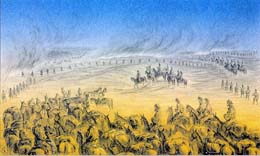On September 5, 1858, artist Gustavus Sohon (1825-1903) sketches a panoramic view of the Battle of Spokane Plains between the U.S. Army troops of Colonel George Wright (1803-1865) and a force of Spokane, Coeur d'Alene, and Palus tribesmen. Sohon arrived on the Columbia River in 1852 as a private in the U.S. Army, and during the following decade, accompanied four expeditions across Eastern Washington. A man of many talents, Sohon serves as a guide, an interpreter, an explorer, and a cartographer, but he is best known as a self-taught artist whose surviving pencil sketches and watercolors of important figures and landmarks comprise valuable eyewitness records of a crucial transitional period in Inland Northwest history.
Defeat and Reprisal
In May 1858, Colonel Edward Steptoe (1816-1865) set out from Fort Walla Walla with a small detachment of soldiers enroute for Fort Colville to investigate the killing of two miners in that area. Upon learning of this expedition, many members of the Coeur d’Alene, Spokane, and Palus tribes were greatly alarmed, for they had promised Governor Stevens to maintain peaceful relations in return for his pledge to keep military troops south of the Snake River. Interpreting Steptoe’s advance as an invasion of their territory, a force gathered from the three tribes and ambushed his column near present-day Rosalia.
Less than three months later, in August 1858, Colonel George Wright crossed the Snake river and marched north to make a retaliatory strike against the tribes involved in the attack. A small topographical team, including engineer John Mullan (1830-1909) and artist Gustavus Sohon, accompanied the troops “to collect and prepare any topographical facts and features that the march might develop” (Mullan, 9). The three-man crew, accompanied by several friendly Nez Perce scouts, worked ahead of the troops, throwing down bridges across creeks and scouting the best line of travel.
On September 5, Wright’s troops were moving through the open country south of the Spokane River when a large tribal contingent “advanced in great force, and set fire to the dry grass of the prairie, so that the wind blowing high and against us, we were nearly enveloped by the flames” (Kip, 63). Sohon was apparently close at hand during this stage of the prolonged skirmish known as the Battle of Spokane Plains, for he rendered a dramatic scene showing Wright’s officers clustered on a bare hillside, surveying a bank of flames from the grass fire set by Indian forces in hopes of stalling the Americans. From his vantage point, lines of advancing infantry stretch along the flanks of the hill, armed with the modern rifles that would completely outgun the arrows and trade muskets borne by their opponents.
Battle of Spokane Plains
Lieutenant Lawrence Kip, another eyewitness to the battle, described the scene with written rather than visual imagery: “It was curious to witness the scene, -- the dust and smoke, and the noise and shouting of the muleteers driving forward to the centre four hundred overloaded animals, while the troops were formed about them” (Kip, 64). As if corroborating Kip’s account, Sohon’s sketch depicts a tight circle of the pack mules so necessary to Wright’s survival, their ears erect, their heads pointing toward the flames. Nearby rests an open wagon carrying the survey equpment of Mullan and Sohon -- the only wagon allowed to accompany the fast-moving troops.
“On the hills to our right,” wrote Kip, “were feats of horsemanship which we have never seen equaled. The Indians would dash down a hill ... at the most headlong speed, apparently with all the rapidity they could have used on level ground” (Kip, 64). Sohon echoes this detail in the background of his drawing, where mounted Indians dashing toward the base of the knoll are visible through a narrow gap in the billows of smoke rising from the prairie.
Paul McDermott and Ronald Grim, who have extensively studied this phase of Sohon’s career, note that the artist made several portrayals of the fight. “The first study was drawn in pencil on plain paper, which is now part of the collection at the Smithsonian, having been donated by Elizabeth Sohon, one of the artist's daughters. A more finished drawing on tricolored paper was created later. In this colorful rendition, the military position dominates while in its midst the smoke created by the grass fires wafts across their position. The fact that Wright ordered the infantry into a linear formation is seen in each of Sohon's drawings illustrating the battle, thus confirming the narrative and cartographic record of the engagement” (McDermott, 22).

